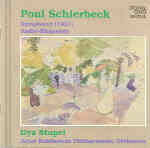Not surprisingly, the principal influence on Danish composer Poul Schierbeck’s marvelous symphony (1921) is Carl Nielsen, who also conducted the work’s premiere. The first movement opens with a gloss on Nielsen’s Fourth Symphony, but the continuation harks back to the Third (particularly its first-movement central waltz). The slow movement, a fascinating and powerfully “Nordic” study in muted colors, impresses as wholly original, while the brief, intermezzo-like third movement returns to the world of Nielsen, and with its single climactic trombone glissando even anticipates the Humoreske of the Sixth Symphony. The finale, a gorgeous theme and variations (more shades of Nielsen’s Sixth!) whose opening gives Elgar’s “Nimrod” a good run for its money (in mood, not melody), leads to a witty and deliciously timed quiet ending that sets the seal on a fascinating and very appealing work.
Where Schierbeck parts company with Nielsen is in his approach to scoring. There’s a plushness to this music, with lavish use of percussion and celesta, utterly foreign to the senior composer’s sound world, and as I noted in my positive review of Schierbeck’s vocal works on Da Capo, he orchestrates to the manner born, with an exquisite sense of sonority and masterly control of texture. These virtues are equally evident in the Radio-Rhapsody, actually a tone poem based on the story of Adrienne Lecouvreur, of all things. It’s great fun, brilliantly written and consistently engaging, as are the performances of both works under Ilya Stupel. He has his orchestra playing this unfamiliar music with impressive confidence and ease, and the recording has plenty of depth, clarity, and impact. If you collect Nielsen or the early 20th century Scandinavian school in general (and if you don’t, you should), snap this disc up without delay.
































